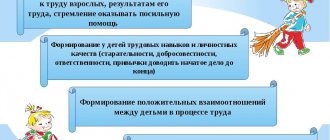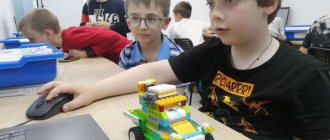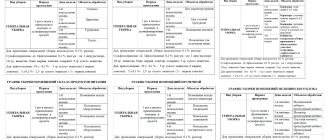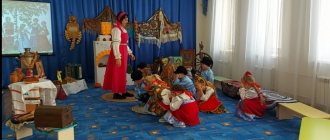Home/Services/SanPiN for kindergartens
In order to guarantee each child proper conditions of care and education, as well as ensuring personal safety during their stay in preschool educational institutions, universal rules have been developed that are mandatory for every kindergarten. Such requirements in 2022 are established by sanitary and epidemiological institutes and are documented in a document called SanPiN.
What is SanPiN?
This set of standards is a list of basic requirements that apply to all private and public institutions involved in the upbringing and education of children. That is, this group of organizations includes not only kindergartens, but also preschool development centers, art clubs and others.
Attention! If you have any questions, you can chat for free with a lawyer at the bottom of the screen or call Moscow; Saint Petersburg; Free call for all of Russia.
Attention
SanPiN in 2022 does not apply to home gardens that are organized by parents independently and formed in multi-storey buildings and residential complexes.
In addition, the text of the document contains recommendations that are not required to be followed. But they help improve the microclimate in groups, as well as increase the efficiency of the learning process in kindergartens.
You can download the SanPiN for kindergarten, which has partially become invalid in 2022, here.
You can download the new SanPiN for kindergarten in 2022 here.
Latest innovations in SanPiN for kindergartens
Sanitary and epidemiological institutes are constantly working to improve the functioning of preschool educational institutions. And such events are aimed at increasing the safety of children, as well as improving the learning and development of children. In connection with this, the current edition of SanPiN is subject to constant changes.
Table No. 1 “Main amendments that entered into force SanPiN for kindergartens in 2022”
| Before | After |
| Prohibition on ventilating premises in the presence of children | One-way opening of windows is allowed if there are pupils in the group, but only in hot and windless weather |
| Lack of distribution of food intake by age of children | Increasing the number of dishes consumed and establishing norms of nutritional value for each age category |
| Strict fixation of temperature conditions: 19 – in the bedroom, 22 – in the playroom | Increasing limit values |
IMPORTANT
In addition, by 2022, amendments were made to SanPiN for kindergartens regarding the furniture used. Now every child should have a personal set of basic furniture accessories. And the use of bunk beds is not advisable.
Nutrition standards in 2022
Each product that will be served to kindergarten students must have a permit document certifying the quality and safety of food in accordance with SanPiN in 2022. In addition, a separate category of standards consists of the rules for storing ingredients and the procedure for their preparation.
The formation of the food menu is based on the main needs of the child’s body necessary for proper physiological development. Which has a direct bearing on the age of the children.
Table No. 2 “Nutritional value of dishes”
| Age in months | Calorie content | Vegetable proteins, g | Animal protein,% of the child’s total weight at the rate of 1g/1kg | Fats, g | Carbohydrates, g |
| 0-3 | 115 | — | — | 6,5 | 13 |
| 4-6 | 115 | — | — | 6 | 13 |
| 7-12 | 110 | — | — | 5,5 | 13 |
| 13-24 | 1200 | 36 | 75 | 40 | 174 |
| 25-36 | 1400 | 42 | 65 | 47 | 203 |
| 37-84 | 1800 | 54 | 60 | 60 | 261 |
Some differences are provided for pupils who are on combination feeding, that is, with a combination of breast and additional nutrition.
There are no uniform requirements for menu design according to SanPiN for kindergartens in 2022, since the need to consume various products is related to the characteristics of each region. But the meal schedule is based on the daily schedule in the kindergarten. When staying in a preschool educational institution around the clock, the following is provided:
- two breakfasts;
- dinner;
- afternoon snack;
- 2 dinners.
Attention:
If the time spent in the garden is no more than 8 hours, then there must be four meals. And it is imperative to adhere to time intervals, which can hardly exceed 4 hours.
Technological maps of dishes in kindergartens
Special attention is given to the nutrition of children in kindergartens, since food is one of the main causes of the spread of infectious diseases. Thus, in 2022, an educational institution will be assigned the following responsibilities:
- choosing a reliable supplier;
- compliance with delivery rules;
- control over the unloading and quality of packaging of products;
- compliance with storage standards for food raw materials;
- following recipes for preparing dishes.
IMPORTANT
Each finished menu item must have a technological map. This is a document that displays basic information about the cooking process, as well as its nutritional value.
The report must contain the following information:
- name of the dish;
- number of the recipe used in preparation;
- the source where the recipe was taken;
- weight and list of outgoing products;
- final weight of the finished dish;
- the amount of carbohydrates, calories, fat, protein and vitamin C in one serving.
Please note:
Such documents are systematized and provided as a report to the sanitary and epidemiological service.
Requirements for the kindergarten territory
The 2022 SanPiN strictly defines the standards by which land plots are selected for the construction of a preschool educational institution. The main ones include:
- location within a residential complex or residential area;
- lack of industrial enterprises nearby;
- the noise level should not exceed the norm;
- measurement of air pollution;
- the possibility of natural lighting for outdoor play areas.
Attention
In regions in the Far North, it is additionally required to equip the area with protection from wind and snow.
One of the most important conditions for designing a kindergarten yard according to SanPiN 2022 is a sufficient amount of green space. Thus, the minimum permissible level of trees and shrubs on the territory is one fifth of the entire area of the site, which is not used for development.
For your information
As a rule, such plantings are used to separate play areas or are placed along the perimeter of the courtyard along the fence, the presence of which is also required. It is strictly forbidden to plant fruit-bearing or poisonous plants on the territory.
In addition, in 2022, according to SanPiN, there are separate requirements for the design of playgrounds for kindergartens. The main ones include:
- mandatory presence of physical education sections for sports;
- availability of a minimum area, which is calculated based on the minimum 7 sq.m. for one child in the group;
- the covering of such areas should be grassy;
- It is necessary to have canopies to protect children from rain and sun;
- It is important to equip an additional area for storing strollers, sleds, skis and other vehicles with protection from rain and snow.
Additional information
Regarding cleanliness, in winter it is necessary to remove snow from the areas. In summer, when the weather is hot, vegetation should be watered at least twice a day. Sanitary cleaning of the area is carried out in the morning and evening (before the arrival and after the departure of pupils, respectively).
Baby's daily routine - parents' work
If everything is more or less clear with feeding (you need to feed, you can’t overfeed), educational games are also in perfect order (young people start going to early development centers at the age of one and a half years), then such important components as proper sleep and physical activity in the fresh air are often omitted air. Namely, these two aspects provide a solid foundation for the development and health of the child.
To provide the child with adequate physical activity, the parent must:
- schedule time;
- overcome fear of weather and colds and try to walk with your child in any climatic conditions (with the exception of frost minus 15 (minus 20 for children over 5 years old) and wind over 15 m/s);
- choose clothes that will simultaneously protect from weather conditions and provide the child with the opportunity to actively move.
To ensure proper rest for the child’s nervous system (and the parent’s as well), you need:
- do not wait until the child goes to bed on his own (fatigue in children often manifests itself as overexcitement, which leads to motor and emotional disinhibition), but gently prepare the child for rest, taking into account the time required by age for wakefulness. To do this, you can introduce so-called rituals (certain sequential actions, quiet games, reading books, bathing, singing);
- exclude active types of games and gadgets before bedtime;
- provide adequate physical activity during the day so that the child does not become overtired or tired;
- try to ensure that going to bed and getting up in the morning are not too different on weekends and weekdays;
- try not to skip daytime sleep;
- avoid turning on the TV in the background during the day
- limiting the time spent using a computer and TV to 15 minutes a day for children over 3 years old.
Daily schedule and working hours of the teacher
Children are admitted to kindergarten personally by a teacher or a medical professional. This need is associated with preventing the admission to classes of children with any infectious or contagious diseases. If a kindergarten worker suspects an improper health condition, the child is not allowed to study.
As for the organization of the educational process and rest regime, most of the standards are advisory in nature. The main ones include:
- the continuous period of activity should not exceed 6 hours in groups with children over three years old;
- It is advisable that walks in the fresh air take three to four hours daily;
- It is not recommended to take children outside when the temperature is less than 15 degrees;
- It is advisable to divide the time of street walks into two periods;
- depending on the length of the children’s stay in kindergarten, the number of meals and the availability of daytime rest are recorded;
- The duration of lunchtime sleep varies between 2-3 hours, depending on the age of the student.
Additional information
In 2022, SanPiN additionally fixes the maximum permissible periods for conducting educational classes for children, which depend on the age of the children. It is mandatory to calculate both the total daily educational time and one-time continuous activities.
Physiological and pedagogical foundations of the daily routine for preschoolers
Physiological and pedagogical foundations of the daily routine of preschool children
The foundation of human health is laid in early childhood.
Therefore, for the upbringing of a healthy person and the correct formation of personality, his living conditions are of great importance, especially during preschool childhood. One of the conditions for the successful development of a child is a well-thought-out daily routine, that is, a properly organized regime. The rational regime has one of the leading places among the conditions that ensure the necessary level of physical and mental development of the child. This is facilitated by a properly structured regime, which presupposes an optimal ratio of periods of wakefulness and sleep during the day, the appropriate alternation of various types of activities and rest during wakefulness: • a certain duration of activities and a rational combination of them with rest; - regular meals; - good sleep; • sufficient exposure to air. The importance of the regime is that it promotes the normal functioning of the internal organs and physiological systems of the body, ensures a balanced, alert state of the child, protects the nervous system from overwork, and develops a conditioned reflex for time: eat, sleep, walk at the same time. Timely rest, proper change of different types of activities are the main and favorable conditions for the normal and timely development of a child. Conditions and features of the organization of the regime in early age groups. To strengthen the health and normal development of the child, it is important that the daily routine be followed throughout the entire period of raising children in a preschool institution, starting from an early age, maintaining constancy, consistency and gradualness in the implementation of routine processes. When organizing the lives of children in early age groups, adults should be guided by the basic principles: 1. Ensure the unity of health and educational work. 2. Ensure a unified approach on the part of all educators, namely: kindergarten, family, continuity in the work of group educators. 3. It is also necessary to ensure frequent and predominantly individual communication between the child and adults, especially during the adaptation period. 4. Create a favorable emotional environment, because In the behavior of a small child, his mood and emotionality play a big role. 5. Friendly communication between an adult and a child, which should be predominantly smooth, calm, affectionate and emotional. You should not be afraid of affectionate addresses to children, but remember at the same time that they come from a pure heart. 6. Remember the golden rule: the behavior of an adult is a role model for a child. 7. Ensure that children in the group are in an active, cheerful state. An important condition is the methodologically correct organization of routine moments, during which it is necessary to observe the basic principles: • The principle of consistency. • The principle of gradualism. Methodological techniques and rules for organizing regime processes When organizing a regime, it is necessary to follow certain rules: 1. Each of the regime moments must take place against the background of the game. 2. When conducting regime processes, we first take a subgroup of the smallest and most weakened children, and we can also take easily excitable children who have poor skills and who are slow. 3. Implementing the principle of consistency and gradualism, we provide for the unity of requirements on the part of adults raising a child in a child care institution and at home. 4. We create a certain mood in children to carry out this or that process (not to injure the nervous system). 5. The implementation of any regime process should proceed without fuss, without causing unpleasant sensations to children. Adults should accompany their actions with gentle, unhurried speech. 6. When carrying out any routine process, we build the child’s confidence that everything will work out, he will be able to complete this or that action to the end, it is necessary to notice something new that the child has learned, etc. 7. It is necessary to monitor the regularity of physiological procedures, but remember that no more than 3-4 children should be in the toilet room at the same time and no more than 3-4 minutes. Mass planting is carried out before the start of the walk, after its completion - before bedtime and after getting up (but not at the same time, but gradually drop off all the children). 8. It is necessary to remember the hygienic requirements: for premises (compliance with the wet cleaning schedule, ventilation); to the size of furniture in accordance with height; to the appearance of children and adults; to the feeding process. 9. When conducting routine moments, it is necessary to use such a method of relationship between an adult and a child as mother therapy. 10. Individual communication and approach to children must be observed. Methodology for carrying out regime moments First of all, it is necessary to cultivate activity and independence. Much attention should be paid to the formation of cultural and hygienic skills. What skills should we develop? By the age of one year, the child should have developed a sense of cleanliness of his body. By the age of 1 year, a child should be able to drink from a cup on his own. Formation of eating skills. By 1 year 6 months we learn to eat on our own. Hand washing skill. Up to 1 year. 6 months. – we teach how to take part in washing – put your hands under the stream of water. From 1 year 6 months - we teach how to wash hands; by 2 years, with the help of an adult (who rolls up his sleeves, tells him how to wash his hands, and also dry himself), the child can wash his hands himself. In the 3rd year, this skill is improved and we begin to teach the child, also with the help and under the supervision of an adult, to wash himself: wash his hands, face, dry with a towel. We teach how to use a napkin, handkerchief, and individual towel. Dressing and undressing skills. Up to 1 year. 6 months. – the child must take part in undressing: take off shoes, socks, hat (at the request of an adult, the child bends his head and extends his hand). By the age of 2, he should learn to take off parts of clothing unbuttoned by adults (boots, tights) and, with a little help from him, put on (pull) individual parts of his clothes, understand the purpose of clothes, and name them. By the age of 3, a child should dress and undress with a little help from adults: take off and put on clothes in a certain sequence, untie laces, unfasten and fasten buttons in front, fold clothes, notice problems (lowered socks, unbuttoned buttons, etc.), etc. with the help of an adult to put yourself in order. To successfully develop cultural and hygienic skills, their systematic reinforcement is necessary. Specifics of organizing routine processes Organizing a walk Staying in the fresh air strengthens health and hardens the body, comprehensively develops children, activates their motor activity and cognitive abilities. A preschool child should walk (even in the cold season) up to 4-4.5 hours a day. In summer, all children's activities can take place outdoors. The walk can be carried out in any weather, with the exception of unfavorable conditions (up to –15 degrees in winter). The walk is not carried out when the air temperature is below –15 and the wind speed is more than 15 m/sec. It is important to remember that a day spent without a walk is lost to health (G.N. Speransky). Getting the kids ready for a walk (as well as returning) is a particular challenge in the daily routine. Every day, staff spend about 15% of their working time on dressing children. Therefore, it is important to rationally organize this moment. In early age groups, classes are conducted in subgroups and, therefore, children gather for a walk as well. To speed up this process, you can use the so-called frontal method of dressing children, when they simultaneously put on leggings, shoes, sweaters, hats, and lastly coats (jackets). At the same time, we should not forget about maintaining consistency and gradualism, as well as an individual approach to children. Of particular importance in the regime is the methodologically correct organization of the feeding process . During meals, the teacher imparts knowledge to the children and expands their understanding and vocabulary. Gently addressing the children, he tells them the names of the dishes, their quality and condition: sweet, tasty, hot, salty, etc. We pay attention to moral education, based on imitation, we develop the children’s skills in accordance with the requirements of the program. From early childhood, it is necessary to cultivate correct behavior while eating: eat silently, do not disturb others, be careful, etc. We form a positive attitude towards the process of eating, towards food. Children should not be force-fed. Children who are force-fed lose their appetite. A positive example from an adult is of great importance. The child is a mirror; in play he copies the actions of adults, especially the negative aspects (this is how parents find out what is happening in the kindergarten). Classes in early age groups are held 2 times a day (morning and evening), lasting 10-15 minutes in subgroups. The assistant teacher plays a big role here, because the rest of the children are under her supervision. Coherence in the work of group personnel During security processes, a clear distribution of responsibilities between group personnel is necessary. The principle of distribution is as follows: the teacher works in the area where the pedagogical requirements are more complex and responsible, in particular, he performs the bulk of the work in the initial period of developing independence skills: he teaches him to eat, wash his hands, and undress independently. The nanny serves children who have already partially mastered the skill. During feeding, the tables at which the children sit should be divided between the teacher and the assistant teacher to observe and provide the necessary assistance so that the children who sit down first finish eating earlier. Otherwise, the rule according to which younger and weaker children are put to bed first is violated. (Babies' sleep should last 2.5-3 hours). Table setting Requirements: in the 2nd year group - the table should be clean; in the 3rd year of life - napkins (paper, cloth) and bread bins are required. Where possible - tablecloths, individual napkins. From the second half of the year we put on the table the 3rd dish (compote). Children quickly get used to it and eat carefully. (Tables and chairs must be marked.) Adults must be able to properly feed children: take a high chair, sit next to them, with a clean spoon (another). When organizing and implementing routine processes, group staff must always remember that the main task here is to take care of the health and physical well-being of the child, so that he is fed on time, put to bed, eats the food he is entitled to with appetite and sleeps soundly for the time prescribed by the regime, so that he was dressed in accordance with the season and microclimate (air temperature, humidity) of the room. In the process of methodically correct implementation of regime moments, the most important task of physical development at an early age is solved.
We recommend watching:
Summary of entertaining activities in kindergarten. Junior group Planned results of mastering the program in the junior group according to the Federal State Educational Standards Features of the development of children of primary preschool age Age characteristics of children 3-4 years old according to the Federal State Educational Standard briefly
Similar articles:
Organization of a walk in the junior group according to the Federal State Educational Standard
Observations of wildlife in the younger group of kindergarten
Observations of inanimate nature on a walk in the younger group
Observations of the work of adults in the younger group
Observations of street life. Junior group
How many children can there be in a group according to SanPiN?
Most accepted standards are based on the age of the children and it is customary to distinguish between two categories of preschoolers:
- under three years of age;
- after three years.
Attention
Also, in 2022, the personal physical and intellectual abilities of children are taken into account. It is on these characteristics that the maximum permissible number of preschoolers in one kindergarten group depends.
Table No. 3 “Categories of children and the maximum number of pupils in a group”
| Categories | The highest permissible group occupancies | |
| Up to 3 years | After 3 | |
| For severe speech disorders | 6 | 10 |
| Severely Hearing Impaired | 6 | 6 |
| Hearing impaired | 6 | 8 |
| Blind | 6 | 6 |
| Significant visual impairment | 6 | 8 |
| Weak confusion | 6 | 10 |
| Mental retardation of severe severity | — | 8 |
| Autism | — | 5 |
| Musculoskeletal system disorders | 6 | 8 |
| For other health conditions | 10 | 15 |
| Healthy kids | 10 (no more than three of which have health problems) | 10, 15 or 17 depending on the disease and its severity |
The table provides information only about combined groups and compensatory groups (whose activities are related to raising children with mental or physical disorders). As for groups with only healthy children, their number depends on the size of the premises and the possibilities of organizing an effective learning process.
How to accustom your baby to a routine?
To accustom your child to a routine, you need to follow the following simple recommendations:
- You can start accustoming your child to the regime after discharge from the maternity hospital. A parent needs to plan, first of all, his life, taking into account walks and meals. But be prepared that not everything will go smoothly right away. Most often, children enter the regime by 3 months.
- it is necessary to introduce some new stages gradually during complete health and at the moment of satisfaction from the fulfillment of urgent desires;
- it is necessary to take into account the age of the child, the nature of feeding, the time of year, state of health, personality characteristics;
- strive to maintain the regularity of events and their sequence;
- introduce rituals that prepare the child to perform a particular action. They facilitate the introduction of new components of the regime.
Temperature
Control over the formation of comfortable conditions for the rest and development of children falls on the shoulders of educators, who must monitor the proper cleaning and preparation of playrooms and bedrooms for the reception of children. So, in addition to observing the temperature regime, it is necessary to control the air humidity and ventilation of the premises.
According to SanPiN, all rooms in which children play, study or relax must be ventilated. And the procedure is carried out according to the following standards:
- at least twice a day for a maximum of 30 minutes with the formation of a draft, but in the absence of children;
- ends half an hour before the students arrive;
- unilaterally in the presence of children and only in hot, dry weather.
According to SanPiN, air humidity in kindergarten rooms in 2022 should not rise above 60% and cannot be below 40. As for temperature, the following limit values are allowed:
- gaming within 21-24, the most optimal is 24 degrees;
- the bedroom ranges from 18-22, but 22 is best.
IMPORTANT
A slight deviation from fixed standards is allowed, but only in the direction of decreasing indicators. Exceeding the maximum permissible figures is strictly prohibited.
How is a daily routine beneficial for a child?
The benefits of a routine are determined by physiological and psychological aspects, which are the basis for creating a daily routine:
- the benefit from the physiological side is the development of conditioned reflexes, with the help of which the body adapts to existing conditions. The child is prepared to perform the necessary tasks and does them without unnecessary stress. Those. energy is saved and distributed evenly for all necessary activities;
- from a psychological point of view, the child’s nervous system needs a stable environment, which, with its predictability, gives a feeling of peace and reliability. This, in turn, creates a favorable background for the child’s development, a deeper understanding of the actions performed and the development of skills.
Child development
Kindergarten is the first step towards the comprehensive development of a child, so it is very important to organize the right approach to raising children. Thus, according to the established rules of SanPiN in 2022, the daily routine in a preschool educational institution must contain the following activities:
- exercises in the group room (should be carried out at least twice and the duration of the exercises depends on the age of the kids and should vary between 5-15 minutes);
- physical activity in the fresh air (which also includes active sports games);
- role-playing games in groups that require active participation;
- swimming (if the kindergarten has swimming pools);
- training sessions (the duration of one block of developmental sessions should not exceed ten minutes and should be replaced by other types of activities);
- physical education (includes several simple exercises).
As for training lessons, they include:
- familiarity with numbers and letters;
- art classes;
- music and choreography;
- modeling from plasticine;
- making crafts from natural materials;
- development of logic and memory.
The teacher is required to be able to correctly distribute all types of employment in order to equally pay attention to all types of activities.
Are there any disadvantages to the daily routine?
The disadvantages of a daily routine, or, more precisely, objections to following a strict daily routine, are as follows:
- kids often get out of their usual routine, disrupting the sequence and timing of events. Their sleep and nutrition are easily disrupted by external factors (weather, physical or mental discomfort, changes in the type and method of feeding);
- children can intuitively follow their needs. This is the basis of the objection to forced obedience to a schedule;
- Strict adherence to the daily routine, ignoring individual living conditions, personality traits and age can lead to rigidity of thinking, inability to adapt to changes in the environment, deprivation of individuality and also to health problems.






